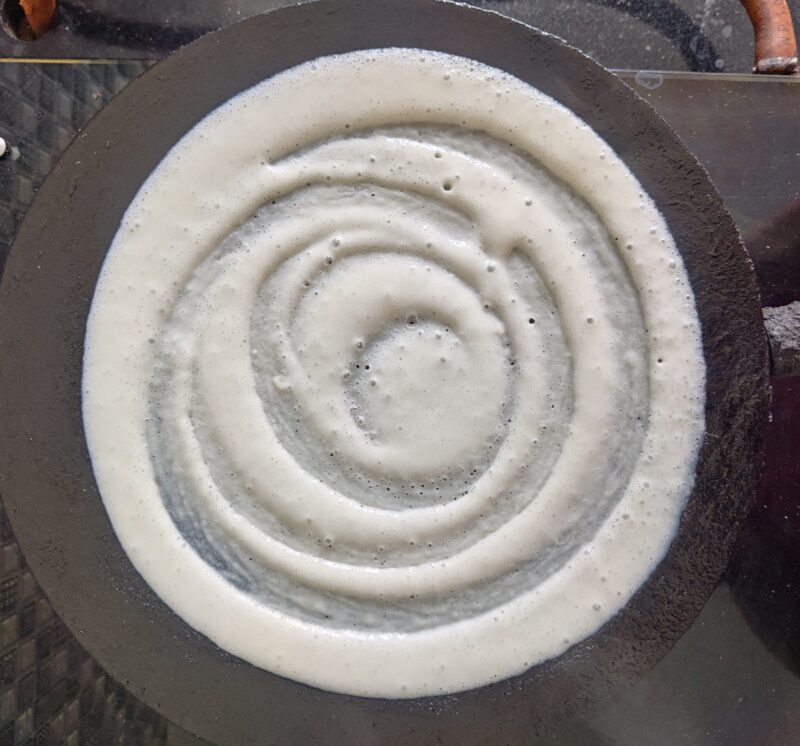
For the Chatamari:
| Proso millet flour | 1 cup |
|---|---|
| Water | ⅓ to ½ cup |
| Cooking Oil | for greasing the tawa |
| Salt | ¾ teaspoon (adjust to taste) |
For the topping:
| Onion, large (Chopped) | 1 |
|---|---|
| Tomato, large (Chopped) | 1 |
| Green chilli (Chopped) | 1 |
| Coriander leaves (Chopped) | 4-5 tablespoons |
| Ginger-garlic paste | ½ tablespoon |
| Turmeric powder | ½ tablespoon |
| Coriander powder | ½ tablespoon |
| Cumin powder | ½ tablespoon |
| Eggs | 4 |
| Salt | to taste |
| Chilli-tomato chutney (optional) | 1 tablespoon |
What You Will Need
A flat-bottomed tawa, mixing bowls, a ladle, measuring cups and spoons, a spatula.
Instructions
Add the proso millet flour and about ⅓ cup of water to a mixing bowl. Stir well to combine.
Check the consistency of the batter and add more water, if required, until it resembles dosa batter. Set aside.
In a separate bowl, combine the onion, tomato, green chillies, coriander leaves, ginger-garlic paste, spice powders, and salt. Mix well.

Place a tawa or non-stick pan on the stove-top. Once hot, test the batter by spreading it on the tawa, then drizzling oil along the edges. Cook for 1-2 minutes, then flip the chatamari.
Once cooked through, remove from the tawa, ensuring it does not break or disintegrate. If it does, add a little more flour to the batter.
Grease the pan again with oil and add a ladleful of the chatamari batter, making sure to spread it evenly.

Drizzle a few drops of oil along the sides of the chatamari.
At this stage, you can spread a thin layer of chilli-tomato chutney onto the chatamari for an added kick of flavour.

Add a portion of the toppings mixture on the chatamari and make sure to spread the mixture evenly.

Crack an egg onto the chatamari. It can be left whole at the centre or spread evenly, based on your preference.

Sprinkle some more coriander leaves over the cracked egg.
Cover the tawa with a lid and let the chatamari cook on a low flame for 3-4 minutes or until the egg is cooked to your desired consistency.
Serve hot.
Tips:
- Always keep the flame at the lowest setting when spreading the batter on the tawa, as well as while cooking the chatamari to avoid burning the bottom.
- Do not spread the batter very thin, as the chatamari is supposed to be soft.
Variations:
- You can add green peas, carrots, or soya granules soaked in boiling water to the toppings.
- You can also add cooked minced chicken or mutton to the toppings.
- Leftover millet batter made for dosas or idlis can be used as a base for chatamari.
- If you are using whole millets, proso millet can be soaked for 8 hours and then ground with water to make the batter. Ferment the batter at room temperature for 8 hours, then continue to make chatamaris. Soaking and fermenting increases the availability of nutrients in millets.
Sharada Sriram’s culinary passion lies in reviving traditional recipes by imparting a contemporary twist to them. She delights in incorporating seasonal, locally sourced produce in imaginative ways. She shares her cooking experiments on Instagram @adupangarai_aroma.
You must be logged in to rate this recipe.

Sign in with email
